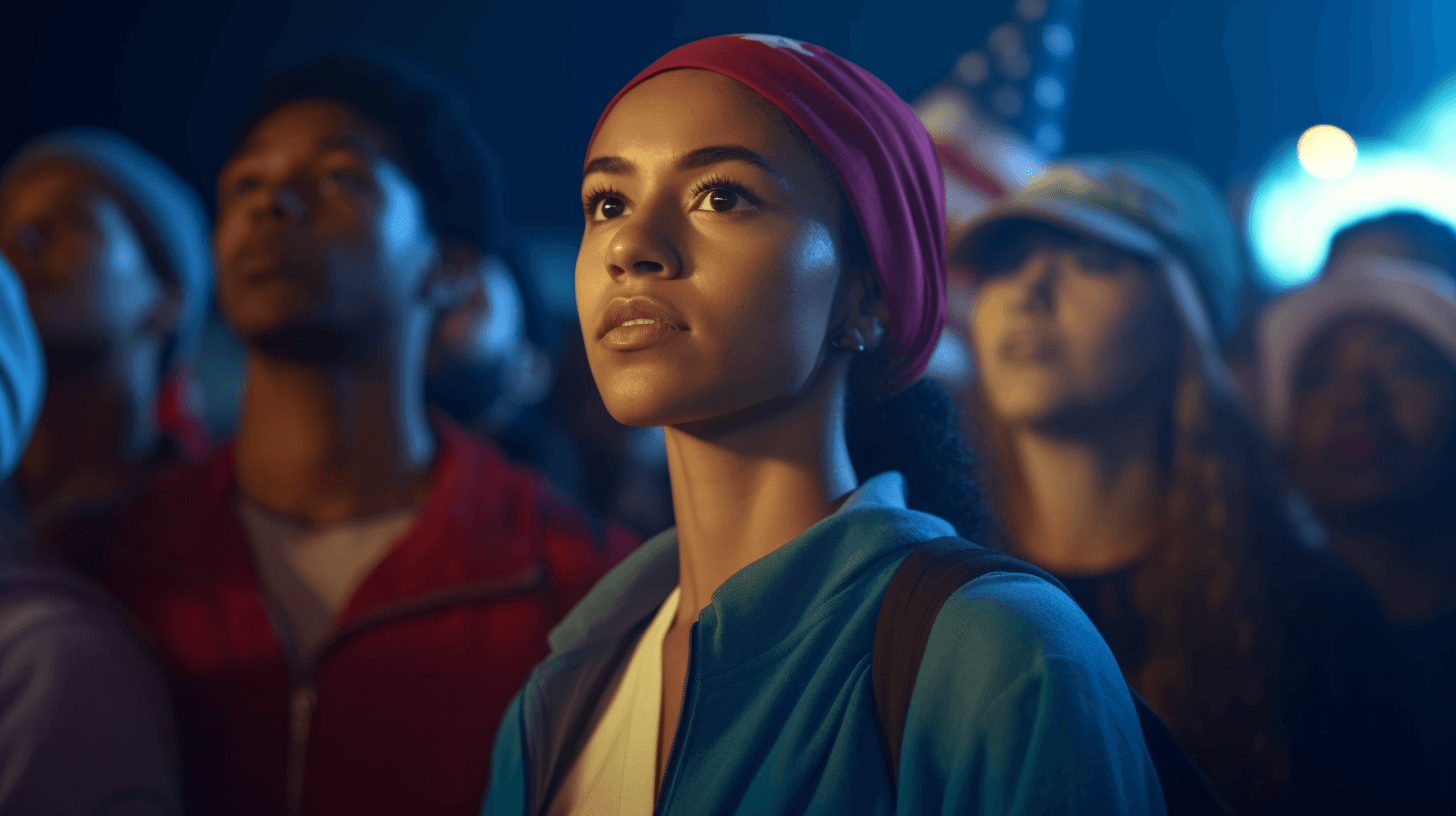📢 Da Millennials No Stay No Special Kine. Dey Went To Da Right. 📈
Ova da past ten years, almost every group of voters unda 50 wen move to da right. 📅📉
Fifteen years ago, one new generation of young voters wen push Barack Obama to one decisive win, showing dat da Democratic Party was going take ova. 🗳️🌟
Fifteen years lata, dose same young voters not so young no moa, and not so Democratic neidah. 🕒😮🐘
Share of Republican Votes in Presidential Elections, By Age 📈📊 In da 2020 presidential election, voters who was 18 to 29 years old in 2008 wen support Joe Biden by 55 percent to 43 percent, according to our estimates. Dass only half of Mr. Obama’s win twelve years ago. 🗳️👵👴
Da exit polls even show um close, wit Mr. Biden winning by just 51-45 among voters who was 18 to 27 in 2008 (exit polls only report results for people 30 to 39, not 30 to 41 — da age group dat was 18 to 29 in 2008). 📊📝
And last fall, da young voters from ’08 — now 32 to 43 years old — wen prefer Democratic candidates for Congress by only 10 points in Times/Siena polling. 🗳️🏛️📊
Dis shift to da right among da young voters who wen help Mr. Obama win fifteen years ago is part of one biggah pattern: Ova da past ten years, almost every group of voters unda 50 has been moving toward da right, based on our analysis of thousands of survey interviews stored at da Roper Center. 🔄📈
Dass not really one shocking discovery. Foa long time, da political folklore wen say dat voters tend to get more conservative as dey get older. But dis finding still go against da wave of recent reports and studies suggesting oddahwise. Da Financial Times, foa example, wen write dat “millennials stay shattering da oldest rule in politics” by not moving to da right as dey age. Same ting, da Democratic data firm Catalist wen find out dat Democrats nevah really lose support among millennials and Gen Z ova da past ten years. Dese findings wen spark one new wave of speculation about whethah da long-awaited era of Democratic dominance might finally be upon us. 🌊📰📚
But if we track da same group of voters ova time, instead of lumping togethah one whole generation dat wen change, we see one different story. Da millennials from 2008 no stay da same as da ones from 2016. Six moa years wen pass, and more millennials wen come of age and dey stay moa Democratic, which balances out da slight Republican shift among da older millennials. ⌛🔄📈
Da biggest shift to da right seems to be happening among da older “young” voters — da older millennials who wen grow up in one different political era from today. Plenny of da issues dat wen attract young voters to da Democrats in 2004 or 2008 — like da Iraq War or same-sex marriage — no moa relevant nowadays. Da Republicans even wen overcome some of da disadvantages dey had on certain issues, whether by opposing foreign intervention at times, attracting some voters wit messages about equality, or positioning demselves as da “anti-establishment” party. 💼💪💙❌🌈🇺🇸
On da oddah hand, da shift to da right stay smallah among da youngah voters — especially dose who came of age aftah Mr. Obama, during da time of Black Lives Mattah, da Bernie Sanders campaign, and Donald J. Trump. Today’s politics still revolve mostly around da same issues dat drew dese voters to da Democrats. As long as dat stays true, dey goin’ stay loyal. ✊🗽🌹👍
We can expect — and it’s probably gonna happen if Mr. Trump is da nominee — dat da 2024 presidential election goin’ be fought ovah similar issues as recent elections. If dat’s da case, den it might end up being like da 2012 presidential election, one momentary period of political stability dat makes da incremental demographic and generational shifts seem significant. But who knows if dat goin’ last long. 🕒🗳️🌊📅📉
NOW IN ENGLISH
📢 The Millennials Are Not Exceptional. They Have Shifted to the Right. 📈
Over the past ten years, almost every group of voters under 50 has moved towards the right. 📅📉
Fifteen years ago, a new generation of young voters pushed Barack Obama to a decisive victory, indicating that the Democratic Party was poised to take over. 🗳️🌟
Fifteen years later, those same young voters are no longer as young, and they are not as Democratic either. 🕒😮🐘
Share of Republican Votes in Presidential Elections, By Age 📈📊 In the 2020 presidential election, voters who were 18 to 29 years old in 2008 supported Joe Biden by 55 percent to 43 percent, according to our estimates. That’s only half of Mr. Obama’s victory twelve years ago. 🗳️👵👴
The exit polls even show it was close, with Mr. Biden winning by just 51-45 among voters who were 18 to 27 in 2008 (exit polls only report results for people aged 30 to 39, not 30 to 41 — the age group that was 18 to 29 in 2008). 📊📝
And last fall, the young voters from ’08 — now 32 to 43 years old — preferred Democratic candidates for Congress by only a 10-point margin in Times/Siena polling. 🗳️🏛️📊
This shift to the right among the young voters who helped Mr. Obama win fifteen years ago is part of a larger pattern: Over the past ten years, almost every group of voters under 50 has been moving towards the right, based on our analysis of thousands of survey interviews stored at the Roper Center. 🔄📈
This is not a surprising finding. For a long time, political folklore has suggested that voters tend to become more conservative as they get older. However, this finding contradicts the recent reports and studies suggesting otherwise. The Financial Times, for example, wrote that “millennials are shattering the oldest rule in politics” by not shifting to the right as they age. Similarly, the Democratic data firm Catalist found that Democrats have not really lost support among millennials and Gen Z over the past ten years. These findings have sparked a new wave of speculation about whether the long-awaited era of Democratic dominance might finally be upon us. 🌊📰📚
However, if we track the same group of voters over time instead of lumping together an entire generation that has undergone changes, we see a different story. The millennials from 2008 are not the same as the ones from 2016. Six more years have passed, and more millennials have come of age, remaining more Democratic, which balances out the slight Republican shift among the older millennials. ⌛🔄📈
The biggest shift to the right appears to be happening among the older “young” voters — the older millennials who grew up in a different political era from today. Many of the issues that attracted young voters to the Democrats in 2004 or 2008, such as the Iraq War or same-sex marriage, are no longer as relevant today. The Republicans have even overcome some of the disadvantages they faced on certain issues, either by opposing foreign intervention at times, appealing to some voters with messages about equality, or positioning themselves as the “anti-establishment” party. 💼💪💙❌🌈🇺🇸
On the other hand, the shift to the right is smaller among the younger voters — especially those who came of age after Mr. Obama, during the time of Black Lives Matter, the Bernie Sanders campaign, and Donald J. Trump. Today’s politics still revolve mostly around the same issues that attracted these voters to the Democrats. As long as that remains true, they will likely remain loyal. ✊🗽🌹👍
We can expect — and it’s probably going to happen if Mr. Trump is the nominee — that the 2024 presidential election will be fought over similar issues as recent elections. If that’s the case, it might end up being like the 2012 presidential election, a momentary period of political stability that makes the incremental demographic and generational shifts seem significant. But who knows if that will last long. 🕒🗳️🌊📅📉







